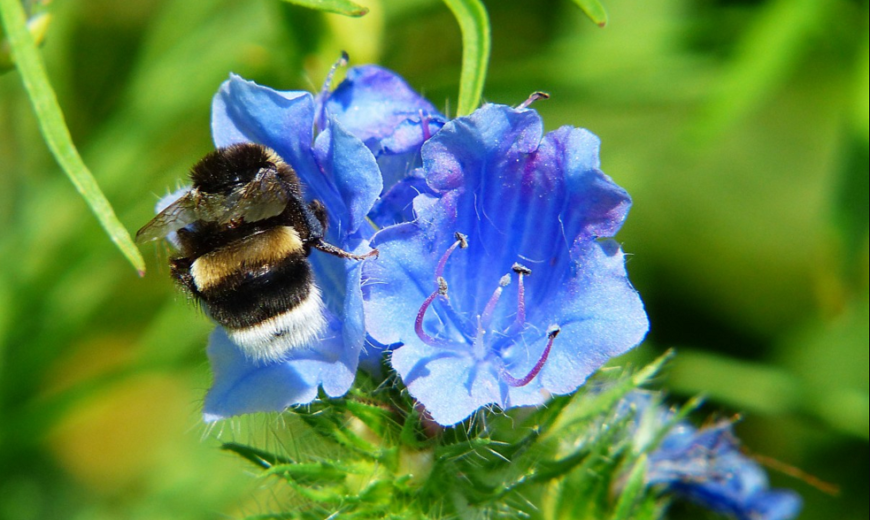Unlawning America: A Call to Inaction

Written by Brian Collier.
The Burlington Parks Recreation and Waterfront Department manages 248 acres of Park land in the City of Burlington. We actively mow approximately 54% of this park space (about 136 acres). This is very hard work and requires significant time and resources by our staff to maintain. Over the past four years, we have begun to allow portions of our formerly mowed park areas to remain fallow. In some of these areas we have initiated forest restoration efforts and installed pollinator plantings. Our overall vision for our open park land is to invoke strategic planning and decision making to carefully determine ways we can conserve resources while striking a balance in the diversity of spaces available to the community.
–Dan Cahill, BPRW Land Steward
Around 40 million acres of the continental U.S. is mowed lawn – four times more land than we use for corn. Much of this is mowed once a week with gas-powered mowers. Imagine the ecological impact of reducing this amount by half, or more. What if we only mowed the places we actively use for sport or play space? What if we mowed less often the lawn we do use? How much lawn do we truly need?
In October 2017 I launched a new art and ecology project titled “Unlawning America” at Burlington City Arts and Shelburne Farms. The project is designed to encourage anyone who owns or manages greenspace to combat some of our environmental problems with a simple strategy: Don’t mow lawns that aren’t used for recreation space. Through intentional inaction, we can have a tangible, and highly visible, positive environmental impact.
The conversation begins by thinking about the overwhelming number of environmental concerns we currently face. Although many of these concerns have gained visibility, it remains challenging to motivate behavioral changes with long-term impact. Americans tend to like quick solutions even where longer-term solutions are required. Many either ignore the problems we face, or they feel so overwhelmed by them they don’t know where to start, so we continue our unsustainable trajectory. This is not an inescapable truth. We have the capacity for positive change.
Less lawn means more habitat for pollinators, birds and other species currently in decline. Less lawn reduces our carbon footprint and means lowering the amounts of chemical pollution going into our soil, water, and air.
Reducing lawn for environmental benefit is not a new idea. Over the past 40 years, there have been many individuals and organizations working toward this goal. There are a number of cultural barriers preventing a large-scale shift away from mowed lawn. These barriers are built upon aesthetics, fear, and the domineering voice of the lawn care industry. You need only look around you, even in a place as environmentally progressive as Vermont, to see that existing programs have been less than effective in producing significant change.
Lawn is referred to as an “ecological desert” because it provides so little for animals. It has been linked to a number of serious environmental problems due to the use of herbicides, pesticides, and fertilizers, as well as excess water use and the pollution caused by mowing. When I give public presentations about “Unlawning America,” I show statistics on the large amounts of water, gas, chemicals and fertilizers used for lawn care and their ecological impacts. Audiences have reacted most visibly to two points: 1. Urban areas use 30-60% of all fresh water for lawns. 2. One hour of mowing with a new gas-powered lawn mower produces more air pollution than 11 new cars driven for the same amount of time.
When all the information is considered, and when combined with the significant cost saving potential, the case for unmowed green space is strong — and the solution I propose is simple. Mow less!
Despite this structural simplicity, changing a well-established culture is challenging. Americans have been conditioned to want large expanses of mowed lawn, and many have been led to believe that turf grass is the best option for both residential and commercial landscapes. This cultural tradition originated with English and French manors, where the lawn was a display of wealth. Lawns appeared in increasing numbers after the Civil War thanks to the availability of mechanized lawn mowers and the proselytizing of landscape architects Jackson Downing and his protégé Frank Scott. There was a great expansion of lawns in the post-WWII period. Because few people think about lawns in a historical context or realize how recent that history is, we unquestioningly accept lawn as an essential component of American middle-class identity.
“Unlawning America” is designed to make environmentally harmful landscaping practices more visible and less ordinary to us. The art and design components created for this project celebrate unmowed green space and model alternatives to mowed lawn. Most important, they frame unmowed green spaces as ecologically and aesthetically valuable, challenging our deeply seated perceptions and reminding us that our expectations were established through cultural tradition and questionable beliefs.
The project has only begun. The title of this project, “Unlawning” America, is sincere: I intend to expand across the entire U.S. and perhaps into Canada. I am working to garner participation from individuals, along with public, corporate and government entities, with shifts along a spectrum ranging from small- to large-scale interventions. In addition to giving public presentations, creating artworks and starting unlawned sites, I am working on a number of strategies to garner broader participation.
By reducing or eliminating mowing, and by not using herbicides, pesticides or fertilizers, we can make significant improvements to our ecosystem. The need for change is immediate, especially for pollinators in decline. Together, starting with inaction, we can help our ecosystem become healthier and more resilient.
For more information visit: http://unlawningamerica.societyrne.net/
